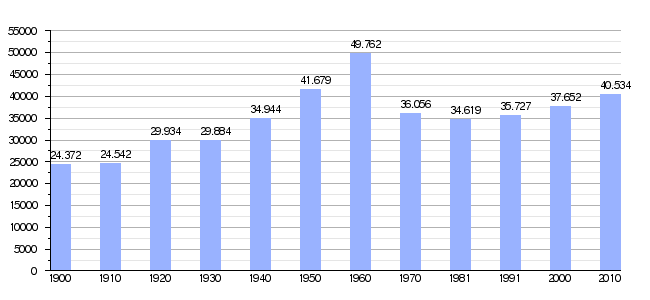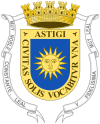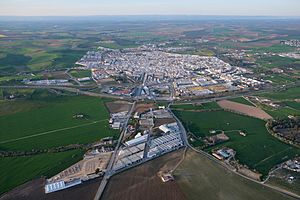Écija facts for kids
Quick facts for kids
Écija
|
|||
|---|---|---|---|
 |
|||
|
|||
| Country | Spain | ||
| Autonomous community | Andalusia | ||
| Province | Seville | ||
| Area | |||
| • Total | 978.73 km2 (377.89 sq mi) | ||
| Population
(2018)
|
|||
| • Total | 39,882 | ||
| • Density | 40.7487/km2 (105.5387/sq mi) | ||
| Time zone | UTC+1 (CET) | ||
| • Summer (DST) | UTC+2 (CEST) | ||
| Postal code |
41400
|
||
Écija is a city and municipality in Spain. It is located in the province of Seville, within the region of Andalusia. The city is about 85 kilometers (53 miles) east of Seville.
In 2008, Écija had about 40,100 people living there. This made it the fifth largest municipality in its province. The Genil River, which is a major branch of the Guadalquivir River, flows through the city.
The economy of Écija mainly relies on farming. People grow olives, cereals, and vegetables. They also raise animals like cows and horses. The city also has a textile industry.
One of the most special things about Écija's look are its beautiful Baroque bell towers.
Contents
History of Écija
Écija has a very long and interesting history. People have lived here for thousands of years.
Ancient Times: Roman Astigi
Archaeologists have found ancient items from as far back as 800 BC. There are also many remains from later Greek and Roman settlements. In Roman times, the town was first called Astigi.
During the Roman civil war, Écija strongly supported Julius Caesar. As a reward, Caesar ordered the town to be made stronger with walls. He also restarted it as a Roman colony, possibly named Colonia Iulia Firma Astigitana. Later, under Emperor Octavian, the colony was further developed and named Colonia Iulia Augusta Firma Astigitana.
Important writers like Pliny the Elder and Pomponius Mela said that Astigi was as important as Cordova and Seville in the 1st century AD. Astigi was a key city in the Roman province of Hispania Baetica. It was also an early center for a Christian diocese.
After the Romans: Suevs and Visigoths
After the Roman Empire, Écija was ruled by the Suevs and then the Visigoths.
Muslim Rule: Istiǧǧa
In 711 AD, an Islamic army took over Écija. The people of Écija fought bravely for six months before giving up. During the Muslim era, the city was known as Istiǧǧa. It was the capital of a large area called a Kūra.
Écija remained a very important farming area. It produced lots of wheat, barley, and sorghum. Because it could grow several crops a year, Écija supplied food to nearby cities like Córdoba and Seville. The city walls were taken down in the early 900s as a punishment for a rebellion. Later, new walls were built by the Almohads, but they enclosed a smaller area.
Christian Reconquest and Border Town Life
Christians took control of Écija on May 3, 1240. For many years, Écija was a border town because it was close to the new Nasrid Kingdom of Granada. This meant it was often involved in conflicts.
Écija became a realengo, which means it was directly controlled by the Crown. Most of the Muslim population was asked to leave in 1263. The countryside around Écija suffered from raids by the Marinids starting in 1275. The Jewish community in Écija also faced problems during the anti-Jewish revolts that spread across Spain in 1391.
Écija became an official city in 1402. It stopped being a border town in 1410 after the conquest of Antequera. By the 1400s, Écija was the third most important city in the Kingdom of Seville, after Seville and Jerez. Around this time, about 18,000 people lived there.
Modern Écija
From the late Middle Ages into the early modern period, Écija was part of the Kingdom of Seville. Many "new christians" (people who had converted to Christianity) from Portugal moved to Écija and became very influential. Starting in the 1600s, olive oil production grew, becoming more important than traditional grain crops.
Écija was a very important city in Andalusia because of its location between Seville and Córdoba. It grew economically in the 1600s and 1700s. It was also known for its wool trade. Écija was a diverse city where people from different parts of Spain and Europe lived and traded together.
A big earthquake in 1755 caused a lot of damage in Écija. This led to many new buildings and a big renewal of the city. Around 1786–1787, about 29,343 people lived in the city.
Sadly, in 1998, the city council decided to remove some very old Roman ruins to build a parking lot. These ruins included a Roman forum, bathhouse, gymnasium, and temple, along with many mosaics and statues.
Geography of Écija
Écija is located in a special part of Spain.
Where Écija Is Located
The main part of Écija sits on the left side of the Genil River. It was built on the river's natural terraces during Roman times. This spot was good for controlling the river and the fertile lands around it.
Climate and Weather
Écija has a hot summer Mediterranean climate. This means it has mild, wet winters and very hot, dry summers. Écija is sometimes called "the frying pan" of Spain because it gets very hot. This is due to its location in the Guadalquivir Valley.
It does not rain much compared to other areas in the valley. However, Écija did experience several floods in December 2010.
| Climate data for Ecija (2001-2023), extremes (2001-present) | |||||||||||||
|---|---|---|---|---|---|---|---|---|---|---|---|---|---|
| Month | Jan | Feb | Mar | Apr | May | Jun | Jul | Aug | Sep | Oct | Nov | Dec | Year |
| Record high °C (°F) | 25.0 (77.0) |
26.6 (79.9) |
30.8 (87.4) |
37.9 (100.2) |
39.8 (103.6) |
42.9 (109.2) |
45.6 (114.1) |
46.6 (115.9) |
44.1 (111.4) |
37.1 (98.8) |
29.9 (85.8) |
24.5 (76.1) |
46.6 (115.9) |
| Mean daily maximum °C (°F) | 15.6 (60.1) |
17.2 (63.0) |
20.2 (68.4) |
23.3 (73.9) |
27.8 (82.0) |
33.1 (91.6) |
36.9 (98.4) |
36.5 (97.7) |
31.4 (88.5) |
26.3 (79.3) |
19.4 (66.9) |
16.4 (61.5) |
25.3 (77.6) |
| Daily mean °C (°F) | 9.6 (49.3) |
10.9 (51.6) |
13.6 (56.5) |
16.5 (61.7) |
20.2 (68.4) |
24.8 (76.6) |
28.0 (82.4) |
28.0 (82.4) |
24.2 (75.6) |
19.9 (67.8) |
13.6 (56.5) |
10.7 (51.3) |
18.3 (65.0) |
| Mean daily minimum °C (°F) | 3.7 (38.7) |
4.6 (40.3) |
7.0 (44.6) |
9.8 (49.6) |
12.5 (54.5) |
16.4 (61.5) |
19.0 (66.2) |
19.6 (67.3) |
17.0 (62.6) |
13.5 (56.3) |
7.8 (46.0) |
5.1 (41.2) |
11.3 (52.4) |
| Record low °C (°F) | −10.1 (13.8) |
−5.9 (21.4) |
−3.3 (26.1) |
0.8 (33.4) |
4.3 (39.7) |
10.0 (50.0) |
11.2 (52.2) |
12.1 (53.8) |
7.1 (44.8) |
3.0 (37.4) |
−2.8 (27.0) |
−5.3 (22.5) |
−10.1 (13.8) |
| Average precipitation mm (inches) | 40.7 (1.60) |
43.8 (1.72) |
53.0 (2.09) |
50.0 (1.97) |
31.1 (1.22) |
6.1 (0.24) |
0.6 (0.02) |
2.2 (0.09) |
21.7 (0.85) |
44.0 (1.73) |
66.5 (2.62) |
54.2 (2.13) |
413.9 (16.28) |
| Source: Agencia Estatal de Meteorología (AEMET OpenData) | |||||||||||||
Population Changes Over Time
| Development of the Écija population since 1900 |
|---|
 |
The population of Écija has changed quite a bit over the years. You can see how it has grown and shrunk at different times by looking at the chart above.
Famous Landmarks in Écija
Écija is home to many beautiful and historic buildings. Here are some of the most well-known:
- Convent of the Holy Trinity and Immaculate Conception
- Royal Monastery of Saint Agnes of the Valley
- Church of Santa María
- St. James' Church
- Holy Cross Church
- St John the Baptist's Church
- Peñaflor House
- Benamejí Palace
- Vallehermoso House
Images for kids
-
View of Écija around 1567 by Joris Hoefnagel, published in the Civitates orbis terrarum.
See also
 In Spanish: Écija para niños
In Spanish: Écija para niños




